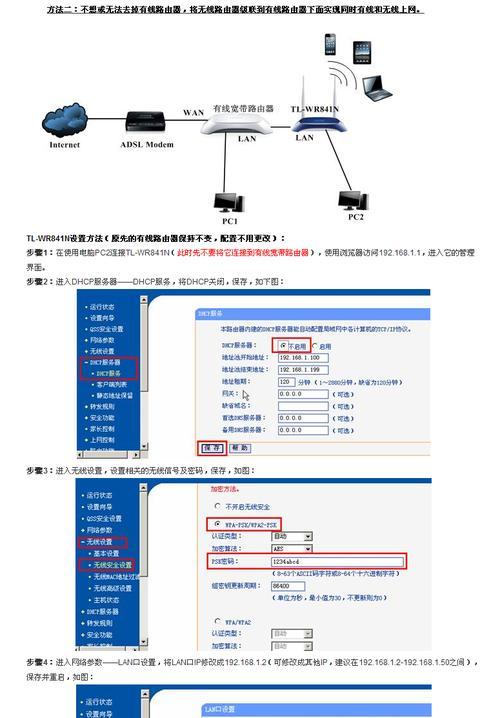 Mobile Tutorial
Mobile Tutorial
 Android Phone
Android Phone
 Connection skills for broadband and wireless routers (building a high-speed and stable wireless network)
Connection skills for broadband and wireless routers (building a high-speed and stable wireless network)
Connection skills for broadband and wireless routers (building a high-speed and stable wireless network)
In the modern connected world, wireless networks have become a necessity, providing high-speed, stable connections for devices. Connecting your broadband to your wireless router is critical to building a strong wireless network. PHP editor Xinyi will guide you on how to make the correct connection to ensure a smooth broadband Internet experience. Read on to learn detailed steps and tips to make it easy for you to enjoy the convenience of wireless networking.

Choose a suitable wireless router (hardware selection)
First of all, you must choose a suitable wireless router, before connecting the broadband and wireless router. Make sure it can meet the needs of your home or office environment, paying attention to factors such as coverage, transmission speed, security, and signal stability.
Confirm the broadband access method (network settings)
You need to confirm the broadband access method you are using before connecting to the wireless router. Optical fiber, Ethernet, etc. need to be set according to different access methods. Common broadband access methods include ADSL.

Connect the broadband to the wireless router (physical connection)
And confirm that the connection is stable, insert the broadband network cable into the WAN port of the wireless router. You need to convert the optical fiber into a network cable before connecting to the wireless router. If you use optical fiber to access broadband.
Set the wireless network name and password (wireless settings)
Ensure the security and independence of the wireless network. Enter the management interface of the wireless router and set up an easily identifiable and secure wireless network. Network name (SSID) and password.
Enable DHCP service (network settings)
And simplify the network configuration process. In the management interface of the wireless router, enable the Dynamic Host Configuration Protocol (DHCP) service to automatically connect to the wireless router. The device is assigned an IP address.

Set port mapping rules (advanced settings)
Set port mapping rules in the advanced settings of the wireless router to improve the network experience as needed. , to ensure that a specific application or device can properly access the external network.
Set up guest network (advanced settings)
You can set up a guest network in the advanced settings of the wireless router to protect the security of the main network. To ensure the security of the main network, the guest network is isolated from the main network, and guests can use independent passwords to connect to the guest network.
Adjust the channel and frequency band (signal optimization)
Improve the stability and transmission speed of the wireless network to reduce wireless interference. In the management interface of the wireless router, select a relatively free one according to the actual situation channels and frequency bands.
Set MAC address filtering (security hardening)
Only allow specified devices to connect to the wireless network. You can set the MAC address filtering function to strengthen network security protection in the security settings of the wireless router.
Adjust wireless power (signal optimization)
You can adjust the wireless power in the management interface of the wireless router according to the required coverage. Coverage within a small range can moderately reduce power, while coverage within a larger range requires higher power.
Set scheduled restart (performance optimization)
You can set the scheduled restart function in the management interface of the wireless router. Improve the performance and stability of wireless routers, and regular restarts help clear cache and release system resources.
Upgrade firmware (system update)
Ensure the security and stability of the network, repair known vulnerabilities and improve performance, and upgrade the firmware of wireless routers from time to time.
Connect and test the wireless network (connectivity test)
Connect tablets or computers and other devices to the wireless network, use mobile phones, and conduct connectivity tests. After completing the above settings, ensure that the wireless network normal operation.
Troubleshooting the wireless network (troubleshooting)
It can be solved by checking the physical connection, resetting the wireless network name and password, and restarting the router if there is a problem with the wireless network. .
And make corresponding settings and optimizations so that we can enjoy the fun of broadband Internet access. By correctly connecting broadband and wireless routers, we can build a high-speed and stable wireless network. I hope this article provides you with some useful connection tips and setup suggestions.
The above is the detailed content of Connection skills for broadband and wireless routers (building a high-speed and stable wireless network). For more information, please follow other related articles on the PHP Chinese website!

Hot AI Tools

Undresser.AI Undress
AI-powered app for creating realistic nude photos

AI Clothes Remover
Online AI tool for removing clothes from photos.

Undress AI Tool
Undress images for free

Clothoff.io
AI clothes remover

Video Face Swap
Swap faces in any video effortlessly with our completely free AI face swap tool!

Hot Article

Hot Tools

Notepad++7.3.1
Easy-to-use and free code editor

SublimeText3 Chinese version
Chinese version, very easy to use

Zend Studio 13.0.1
Powerful PHP integrated development environment

Dreamweaver CS6
Visual web development tools

SublimeText3 Mac version
God-level code editing software (SublimeText3)

Hot Topics
 1386
1386
 52
52
 How to restore the original appearance of mobile phone desktop icons (easily solve the problem of mobile phone desktop icon confusion)
Sep 02, 2024 pm 03:05 PM
How to restore the original appearance of mobile phone desktop icons (easily solve the problem of mobile phone desktop icon confusion)
Sep 02, 2024 pm 03:05 PM
In the process of daily use of mobile phones, we often encounter the situation where the mobile phone desktop icons are messed up, which bothers us. However, with some simple operations, we can easily restore the original appearance of the mobile phone desktop icons. This article will introduce some effective methods to solve this problem. Back up desktop layout Before restoring mobile phone desktop icons, we first need to back up the current desktop layout. Open the phone settings, find the "Desktop and Wallpaper" option, then click the "Backup and Restore" button, select "Backup Desktop Layout", and the phone will automatically save the current desktop layout. Use the icon manager that comes with the system. Most mobile phone systems provide the icon manager function, which can help us restore mobile phone desktop icons. Open your phone settings and find "Apps & Notifications"
 How to deactivate the safety mode of oppo mobile phones (quickly and easily deactivate the safety mode of oppo mobile phones)
Sep 02, 2024 pm 03:38 PM
How to deactivate the safety mode of oppo mobile phones (quickly and easily deactivate the safety mode of oppo mobile phones)
Sep 02, 2024 pm 03:38 PM
In some cases, your Oppo phone may enter safe mode, resulting in the inability to use the phone's functions normally. In this situation, you may feel confused and anxious. However, don't worry! This article will introduce you to some quick and easy methods to disable the safe mode of your Oppo phone and let you use your phone again. 1. Check the battery power If the battery power of your OPPO phone is too low, it may cause the phone to automatically enter safe mode. Please make sure your phone is fully charged and try restarting your phone. Press and hold the power button In some cases, OPPO phones can exit safe mode by long pressing the power button. Try holding down the power button for a few seconds to see if you can exit safe mode. Check the volume keys Sometimes, pressing the wrong combination of volume keys will also
 Steps and precautions for registering a Hong Kong Apple ID (enjoy the unique advantages of the Hong Kong Apple Store)
Sep 02, 2024 pm 03:47 PM
Steps and precautions for registering a Hong Kong Apple ID (enjoy the unique advantages of the Hong Kong Apple Store)
Sep 02, 2024 pm 03:47 PM
Apple's products and services have always been loved by users around the world. Registering a Hong Kong Apple ID will bring more convenience and privileges to users. Let’s take a look at the steps to register a Hong Kong Apple ID and what you need to pay attention to. How to register a Hong Kong Apple ID When using Apple devices, many applications and functions require using Apple ID to log in. If you want to download applications from Hong Kong or enjoy the preferential content of the Hong Kong AppStore, it is very necessary to register a Hong Kong Apple ID. This article will detail the steps on how to register a Hong Kong Apple ID and what you need to pay attention to. Steps: Select language and region: Find the "Settings" option on your Apple device and enter
 Solution to the problem of blurry screen on Samsung monitor (how to deal with the phenomenon of blurry screen on Samsung monitor)
Sep 04, 2024 pm 01:32 PM
Solution to the problem of blurry screen on Samsung monitor (how to deal with the phenomenon of blurry screen on Samsung monitor)
Sep 04, 2024 pm 01:32 PM
With the continuous development of technology, monitors have become an indispensable part of people's daily life and work. However, sometimes we may encounter some problems, such as screen blur on Samsung monitors. This article will introduce some common solutions to help you better deal with this problem. 1. Check whether the connection cable is secure - make sure the VGA, DVI or HDMI cables are intact and firmly connected to the monitor and computer or other devices. - Check whether the interface of the connecting cable is loose or dirty, and clean or replace it if necessary. 2. Adjust resolution and refresh rate - Adjust the resolution and refresh rate of the monitor on your computer system to ensure it matches the monitor's default settings. - Try different settings to see if they can resolve the blurry screen issue.
 How to identify genuine and fake shoe boxes of Nike shoes (master one trick to easily identify them)
Sep 02, 2024 pm 04:11 PM
How to identify genuine and fake shoe boxes of Nike shoes (master one trick to easily identify them)
Sep 02, 2024 pm 04:11 PM
As a world-renowned sports brand, Nike's shoes have attracted much attention. However, there are also a large number of counterfeit products on the market, including fake Nike shoe boxes. Distinguishing genuine shoe boxes from fake ones is crucial to protecting the rights and interests of consumers. This article will provide you with some simple and effective methods to help you distinguish between real and fake shoe boxes. 1: Outer packaging title By observing the outer packaging of Nike shoe boxes, you can find many subtle differences. Genuine Nike shoe boxes usually have high-quality paper materials that are smooth to the touch and have no obvious pungent smell. The fonts and logos on authentic shoe boxes are usually clear and detailed, and there are no blurs or color inconsistencies. 2: LOGO hot stamping title. The LOGO on Nike shoe boxes is usually hot stamping. The hot stamping part on the genuine shoe box will show
 Choose the best video player software (compare the pros and cons of different video player software)
Sep 02, 2024 pm 03:03 PM
Choose the best video player software (compare the pros and cons of different video player software)
Sep 02, 2024 pm 03:03 PM
With the popularity of the Internet and smart devices, video has become an indispensable part of people's daily lives. When choosing a video player software, we hope that it can provide a good user experience, stable playback performance, and support a variety of common video formats. This article will introduce several well-known video player software currently on the market, and evaluate them based on their functions and features, so that readers can choose the software that best suits their needs. 1. Introduction and comparison of popular video player software Windows Media Player: easy to use, comes with Windows system, supports common formats, limited functions VLC Media Player: powerful decoding capabilities, widely supports various formats, simple interface PotPlayer: highly customizable Support multiple formats
 How to check WiFi password on Android phone (simple operation allows you to easily obtain the password of the connected WiFi)
Sep 02, 2024 pm 05:10 PM
How to check WiFi password on Android phone (simple operation allows you to easily obtain the password of the connected WiFi)
Sep 02, 2024 pm 05:10 PM
With the popularity of wireless networks, we often connect to different WiFi networks, but sometimes we forget the password of a certain WiFi network. This article will introduce how to check the password of the connected WiFi on an Android phone, so that you can easily obtain and record it. Paragraph 1. Enter the WiFi settings page through system settings. Enter the WiFi settings page by clicking the "WiFi" option in the phone settings. 2. Select the connected WiFi network. In the WiFi settings page, find and click the name of the connected WiFi network. 3. Enter the WiFi network details page. In the pop-up window, click "Network Details" or similar options to enter the WiFi network details page. 4. Display the high speed of the connected WiFi
 How to clean colored silicone mobile phone cases (simple and practical cleaning tips and precautions)
Sep 02, 2024 pm 04:09 PM
How to clean colored silicone mobile phone cases (simple and practical cleaning tips and precautions)
Sep 02, 2024 pm 04:09 PM
Colored silicone phone cases are one of the common accessories for modern mobile phone enthusiasts. However, after a period of use, dirt and dust will inevitably accumulate on the phone case, affecting its appearance and hygiene. How to properly clean colored silicone phone cases is something every mobile phone user should know. This article will introduce you to some simple and practical cleaning tips and precautions to help you clean colored silicone phone cases easily. 1. Preparation before cleaning Before cleaning, first make sure that the phone is turned off and separate the phone from the phone case. Then prepare the following tools: a soft-bristled brush, mild detergent, warm water, and a clean towel. 2. Use a soft-bristled brush to remove most of the dust. Use a soft-bristled brush to gently brush off most of the dust on the surface of the colored silicone phone case. You can place the phone case on a paper towel to prevent the dust from scattering. want



